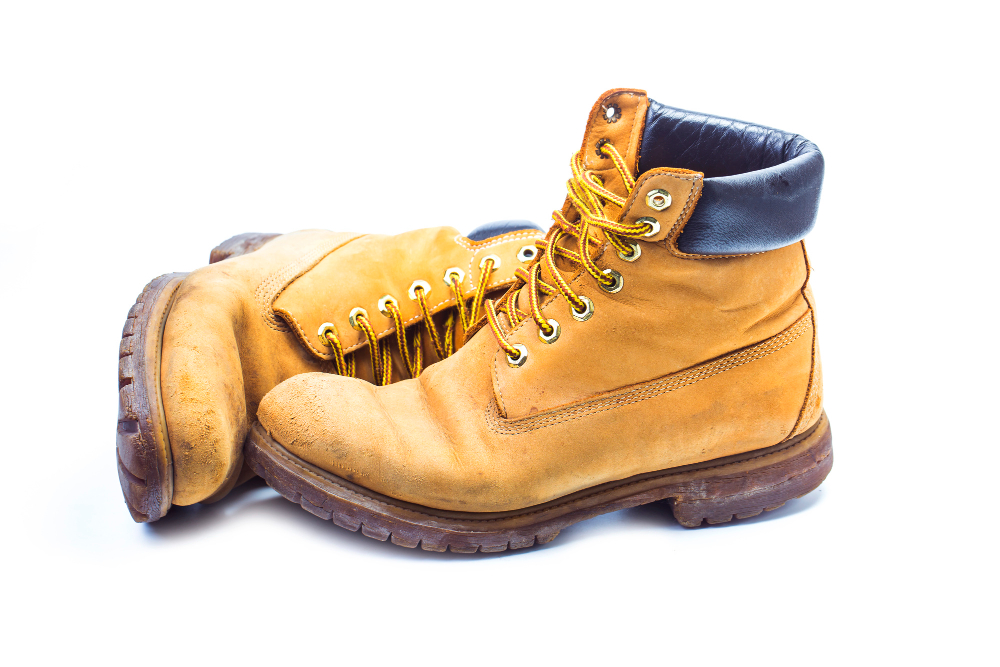The terms “safety toe” and “steel toe” are often used interchangeably to refer to protective features in work boots. While both provide protection against impact and compression hazards, “safety toe” is a broader term that encompasses various materials like steel, composite, or aluminum, whereas “steel toe” specifically refers to a safety toe cap made of steel.
Safety Toe

(Image by dashu83 on Freepik)
Safety toe boots are a popular choice among workers who want an extra layer of protection for their feet. These boots feature a reinforcement in the toe box that is designed to protect your toes from impacts and compression. Safety toes can be made from various materials, including composite materials and aluminum.
One of the benefits of safety toe boots is that they tend to be lighter than steel toe boots, which can make them more comfortable to wear for long periods. They also don’t conduct heat or cold like steel does, meaning your feet won’t get too hot or too cold depending on the weather.
However, there are some downsides to safety toe boots as well. Because they’re not made of metal like steel toes are, they may not provide as much protection against heavy falling objects. Additionally, some people find that safety toes can feel uncomfortable or restrictive if they don’t fit properly.
Safety toe boots are a great option for those looking for added foot protection without adding extra weight and bulkiness to their footwear.
Steel Toe

(Image by rawpixel.com on Freepik)
Steel toe boots are a type of safety footwear designed to protect the toes from heavy objects and impacts in hazardous environments. The steel cap covers the entire front part of the boot, providing maximum protection against falling objects or accidental kicks.
One of the main advantages of steel-toe boots is their durability. They are made with high-quality materials that can withstand extreme conditions, making them ideal for workers in construction, manufacturing, mining, and other similar industries.
Another benefit of steel toe boots is their versatility. They come in different styles and designs suitable for various work situations. There are hiking-style steel-toe boots perfect for outdoor activities such as trekking or hunting. Some have extra insulation to keep feet warm during winter months.
However, one downside to these types of shoes is that they tend to be heavier than regular footwear due to the metal reinforcement on the tip. This factor makes it harder for some people who may not be used to wearing heavy shoes all day long.
Despite this drawback, many workers still prefer steel-toe boots over regular ones because they provide peace-of-mind when working on challenging jobsites where accidents can happen at any moment without warning.
Steel Toe Boots offer superior protection against workplace hazards while being versatile enough for everyday use outside work hours too!
Safety toe Vs. Steel toe – Key differences
When it comes to protective footwear, safety toe and steel toe are the two options that come to mind. While both offer protection against accidents in hazardous work environments, they have their differences.
Let’s take a look at safety toes. These types of shoes are equipped with a composite material or aluminum alloy that offers excellent resistance against electrical hazards. They’re also lightweight compared to steel toes which makes them more comfortable for extended wear.
On the other hand, steel-toed boots feature a hardened steel cap over the toe box area which provides top-notch protection against falling objects and compression while working on construction sites or heavy machinery.
Another significant difference between these two is thermal conductivity. Steel toes conduct temperature much faster than safety toes making them unsuitable for extreme hot/cold conditions where frostbite or burns can occur.
Whether you choose safety toe or steel toe boots depends on your job requirements as well as personal preference. Safety-toe shoes may be better suited for those working in electrical industries while those who deal with heavy loads will benefit from having a durable pair of steel-toed boots.
What are the downside steel toe?
When it comes to safety footwear, steel toe boots are often the go-to choice for their durability and protection. However, there are some downsides to wearing them.
One of the main complaints about steel toe boots is that they can be heavy and uncomfortable to wear for long periods of time. This can cause fatigue in your feet and legs, making it harder to focus on your work.
Another issue with steel toe boots is that they can get quite cold during colder months. The metal cap conducts heat away from your toes, leaving you feeling chilly even when wearing thick socks or insulated liners.
Steel toe boots are also known for causing blisters and discomfort if they don’t fit properly. It’s important to choose a pair that fits snugly without being too tight or rubbing against your skin.
Steel toe boots tend to be more expensive than other types of safety footwear due to their durable construction and materials used. This may not be feasible for those who need new work shoes frequently or who have a limited budget.
Despite these drawbacks, many workers still opt for steel toe boots because of their reliable protection in hazardous workplaces.
What are the downside safety toe?
Safety toe shoes are intended to provide protection to the feet of workers in hazardous jobs. However, despite their benefits, safety toes also have some downsides that should be considered before deciding to use them.
One of the main drawbacks of safety toe shoes is that they can be quite heavy and uncomfortable. The added weight and stiffness of the steel or composite material used for the toe box can make it difficult for workers who need to move quickly or stand on their feet for extended periods.
Another issue with safety toes is that they often don’t allow air circulation inside the shoe. This can lead to sweaty feet, which can cause blisters and other foot problems over time.
Safety toe shoes also tend to be more expensive than regular work boots due to their specialized design and materials. This may not be a significant concern for employers who prioritize worker safety but could impact individual workers’ budgets.
Some people may find it challenging to get a proper fit when wearing safety toes due to differences in foot shape and size. Ill-fitting footwear can cause discomfort and even injury if worn regularly over long periods.
While there are certainly downsides associated with using safety toes at work, many people still consider them an essential piece of protective equipment given their ability to prevent serious workplace injuries.
What are the benefits of safety toe and steel toe?
When it comes to workplace safety, investing in the right pair of work boots can make all the difference. Safety toe and steel toe are two popular options that offer different benefits depending on your specific needs.
One benefit of safety toe boots is their lightweight design. Made from composite materials such as carbon fiber or Kevlar, they provide protection without adding unnecessary weight to your feet. This makes them great for jobs where agility and speed are necessary.
In contrast, steel toe boots provide unmatched durability and strength. They’re designed to withstand heavy impacts and compression, making them ideal for construction workers or those who frequently deal with falling objects.
Both types of work boots also come equipped with slip-resistant soles that help prevent slips and falls on wet surfaces. Additionally, many models feature insulation materials that keep your feet warm during cold weather conditions.
Choosing between safety toe or steel toe depends on factors like the industry you work in and what kind of hazards you face on a daily basis. By selecting footwear that’s specifically tailored to your job requirements, you’ll be taking an important step towards protecting yourself while at work.
Which type of toe is right for you?
Choosing between a safety toe and steel toe ultimately comes down to personal preference and the type of work you engage in. Safety toes are great for those who need protection from electrical hazards, while steel toes offer better protection against heavy objects. However, there are additional factors that may influence your decision.
Consider the weight of each type of toe as some individuals find steel toes too cumbersome for their liking. Additionally, think about the level of comfort each provides; safety toes generally have more padding than their steel counterparts but can be restrictive due to its rigid nature.
Assess your budget as prices vary depending on the materials used in construction. Whether it’s choosing between a composite or aluminum safety toe or opting for an industrial-grade stainless-steel cap versus a basic model – remember that investing in quality footwear is worth it if you’re working long hours on your feet.
Only you can decide which type of toe is right for you based on your individual work conditions and personal preferences.
Featured Image By pvproductions on Freepik








